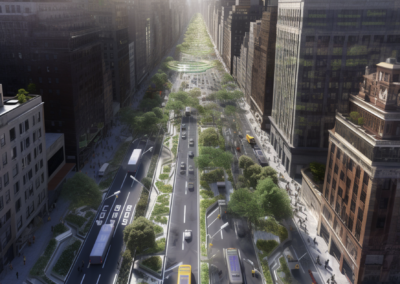Quote of the Week:
“Don’t look back!”
In this phase of the project, we went full speed to the future (without looking back) and took the time to explore possible scenarios through some of the current technological trends. It was time to step away from the solution space and focus on imagining what the world might look like in 10, 20, and even 30 years from now. We saw the decades glowing in bright green but with the price of increased radical restrictions in the society. Considering the forthcoming changes, it was also relevant to discuss possible ethical concerns that, for instance, motion detection and environment tracking could bring along.
A Glimpse of 2030 to 2050
Having initially started picturing a plausible future scenario that would guide our design process from project phase 1, we already had some sort of vision of the environment where Auriel could help people navigate the city. However, it was now necessary to extend this perspective even further and visualize it for better perception. Building the scenario with the help of STEEPLE Analysis (some old-school people like myself, might recall this as the PESTLE Analysis), generated a convenient foundation for us to define a holistic picture of the world from 2030 until 2050. We analyzed Auriel’s external environment through social, technological, and economic factors, and by parsing environmental, political, and legal aspects. As a result of the analysis, we had the future outlined with an image of wider urban parklands, smarter infrastructure, and sustainable achievements, together with a flip side of the coin through extreme regulations, expensive car and airplane use, and a cramped urban living environment.

A Steeple Analysis of a plausible future vision until 2050.
Ethical Considerations
As with any technology-driven business or innovation in the new AI-ruled era, it is relevant to understand the importance of addressing foundational security, privacy, and regulatory concerns, which together form organizational ethics [1]. As designers, we have the power to either improve or worsen existing conditions through innovation and development. Realizing our potential to significantly influence people’s lives through a positively transformative product served as a powerful motivating force to work even harder for this project. Despite the long workdays ahead, our team stayed determinated to invent a product that not only fosters increased traffic safety but ultimately leads to better societal health and well-being. During weekly meetings (and outside of them), we maintained active conversations about system security and privacy that a complex network like Auriel, which relies on big data and information communication, would need to have in place and properly managed. The perspectives presented among the team members also echoed the concerns of citizens’ possible mistrust of the system in case anonymity of collected data was not maximized, raising the need to look for solutions to minimize data storage.
Exploring Technology Trends
Because our solution space was heavily relying on technologies and concepts such as AI, Internet of Things (IoT), systems communication, environment tracking, and detection technologies, responsible use of all these elements would play an extensive role in our design process. Hence, it would be reasonable to examine the present and future technological trends and continue to decode the future through speculative scenarios and factors. We were introduced to a card game developed by Future Today Institute [2], which allowed us to imagine up to 15,625 possible futures (can you imagine?!) as our playgrounds. From the game, we selected only a few of the most interesting and relevant cards to explore future signals of change. Furthermore, we reviewed numerous scientific articles concerning smart cities and intelligent traffic monitoring systems and watched TED talks on the topics of digital ethics and the future of humanity. With comprehensive research, we actively participated in weekly team meetings being well-prepared for discussions on the topics. The endless flood of information again challenged the boundaries of our comfort zones and occasionally even pushed us to the edge of discomfort, leaving us uncertain of the work direction. As we gathered our thoughts, eventually the puzzle pieces fell into place, and we recognized the essential role of struggle and knowledge acquired through the process which were integral parts of Auriel’s impressive development.
AI-generated Artwork
After getting inundated with information once again, we proceeded to create artwork and explore various generative AI tools. We began by creating basic prompts for a greener New York and tested them with DALL-E program, realizing the AI-generated images did not fully meet our expectations. Thankfully, better artwork awaited us as we switched to Midjourney, another AI image generator, which impressed us with its detailed and high-quality illustrations. By this stage, our prompts had grown into long and detailed descriptions that represented our future scenario as a whole. These small but successful steps brought us closer to the final project deliverables, as we now had illustrations ready for the white paper and upcoming presentations.
Mid-point Presentation & a Visit to Pratt Institute
During this phase of the project, we had our mid-point presentation to the CBI community, introducing the design concept and the progress of Auriel’s features and components. Despite some last-minute changes (and the prevalent panic behind the scenes), we delivered a strong presentation and received valuable feedback from our Global Design Factory peers, engineers, and technology experts, improving the development of our product concept.
Speaking of the CBI community, NYC Design Factory’s close proximity to Pratt Institute (just a few subway stops away in Brooklyn) enabled a collaborative relationship between the two institutions. Team Fusion and a buddy team Beta Space from Pratt arranged a meeting on Pratt’s campus in Fort Greene to discuss our ongoing. Several months had passed since our teams last met at CERN in Geneva, so there were plenty of things to catch up on.
References:
- Deloitte & Markkula Center: https://www3.weforum.org/docs/WEF_Ethics_by_Design_2020.pdf
- Future Today Institute: https://futuretodayinstitute.com/tools/




Recent Comments